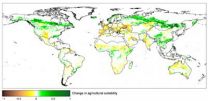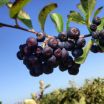(Press-News.org) The fall foliage season that prompts millions of Americans to undertake jaunts into the countryside each year could come much later and possibly last a little longer within a century, according to new research.
Climate change could postpone fall leaf peeping in some areas of the United States as summer temperatures linger later into the year, Princeton University researchers report in the journal Global Ecology and Biogeography. For instance, the paper birch — a popular foliage tree that is the state tree of New Hampshire — could change color one to three weeks later by the end of the century, the researchers found. Although some trees will be less susceptible to the ongoing heat than the paper birch, the more southern the region, the more likely there is to be a greater overall delay in leaf coloration, the researchers found.
Trees need daily temperatures to be low enough and daylight hours to be short enough to produce the vivid vistas of fall, explained senior author David Medvigy, an assistant professor of geosciences and associated faculty member at the Princeton Environmental Institute. He and first author Su-Jong Jeong, a former Princeton postdoctoral student now at NASA, found that daily temperature and daylight hours can not only be used to predict the timing of leaf coloration, but that the influence of these factors depends on the individual tree species and the specific geographic area.
"We're really interested in understanding how these systems will change as we experience global warming or climate change," Medvigy said. "What these results are suggesting is that different locations will change in different ways, and that these differences are actually going to be quite interesting."
Aside from fall foliage and its economic importance to many areas, the research has broad implications for predicting growing seasons, agricultural productivity and ecosystem productivity, Medvigy said. In particular, a delay in when leaves change color could affect how much carbon an ecosystem removes from the atmosphere, which would partially combat the climate change that caused the delay in the first place, he said.
"When plants have green leaves, they're doing photosynthesis and taking carbon out of the atmosphere," Medvigy said. "The longer you have green leaves, the more carbon dioxide you can take out of the atmosphere. At least, that's how the current thinking goes. So, figuring this out could potentially be important for understanding the impacts of climate change."
Mark D. Schwartz, a distinguished professor of geography at the University of Wisconsin-Milwaukee, explained that fall leaf coloration marks the end of the growing season in temperate climates, so understanding its current and future cycles illuminates what's to come for agriculture, water supplies and animal behavior, among many other areas.
Longer or shorter growing seasons influence the type of crops that are planted, the pests that are present, and when animals begin feeding (either on plants or animals that eat plants) and reproducing, said Schwartz, who is familiar with the research but had no role in it. In the western United States particularly, water availability is affected by plants, which are like "little water pumps" that drain soil moisture throughout the entire growing season, he said.
Spring, the onset of the growing season, is well studied, but fall — which is more complex and dependent on geography — is more difficult for scientists to characterize, Schwartz said. Existing models tend to be based on localized data and do not account well for how plants respond to regional fall conditions, he said. Medvigy and Jeong provide valuable, consistent criteria — temperature and light level — for determining leaf coloration that still allow for regional differences, Schwartz said.
"When you get at the growing season you can relate this to a huge number of things. In order to understand how it might change in the future we have to understand how it functions now," Schwartz said. "This research is a useful addition to what we're trying to do in terms of improving the way that we model plants. A lot of models that we use in terms of global change are fairly simplistic."
The study originated when Medvigy, who studies the larger outcome of small-scale interactions between the land and atmosphere, noticed that models had a difficult time explaining the timing of when leaves should change color. He and researchers at the Geophysical Fluid Dynamics Laboratory (GFDL) — which is operated by the National Oceanic and Atmospheric Administration and based on Princeton's Forrestal Campus — had an idea for solving this problem by using continental-scale data.
"What we noticed from observations was that some trees were keeping their leaves later in the autumn," Medvigy said. "We tried to make predictions of these phenomena with our models a few years ago, but the results were disappointing. These interesting phenomena have been going on and we had no way of explaining them."
Medvigy and Jeong sought to test if having information on several species spread over a large area would improve a model's projections. They collected data on leaf-change dates for several tree species, both in Alaska using the USA National Phenology Network, a free online database of seasonal-change observations recorded by scientists and the public, and in Massachusetts using data and observations from Harvard Forest, a 3,500-acre research property managed by Harvard University.
The species examined were American beech, aspen, black oak, northern red oak, paper birch, red maple, sugar maple and sweet birch. They grouped the tree species into three categories based on their tolerance of shade. For example, birches need a great deal of sunlight; beeches can survive in a shaded environment; and oaks are somewhere in the middle. The nearly 20 species the study reviewed fell neatly into one of these three categories.
Medvigy and Jeong found that prediction modeling for the entire United States indeed improves dramatically when the analyses include data from macro-scale observations, meaning from multiple sites spread over a large area. In addition, they report that temperature and duration of sunlight are both significant factors in determining when tree leaves color in the fall. Previous studies have tended to rely on one factor or the other, not both, Medvigy said. Predictions based on those studies were less effective over broader regions.
The researchers also found that the timing of leaf change is more sensitive to temperature in warmer areas than in colder regions. So if there is an increase in fall temperatures, for example, tree species in Massachusetts will respond to a greater degree than species in Alaska, Medvigy said. Alaska's foliage season is in September and is unlikely to change in the next 100 years. But Massachusetts' foliage season will likely occur in November instead of October as it does now, he said. It would take place in southern states even later. With northern climes remaining unchanged and southern areas experiencing coloration later, there is an altogether extended coloration season under climate change, Medvigy said.
Now that Medvigy knows what information is needed to predict what the future holds for leaf coloration, he plans to again collaborate with his colleagues at GFDL to do more sophisticated modeling based on the study results, he said.
"We now have a much better understanding of how temperature, day-length and leaf color are related," he said. "This understanding will help us make better forecasts for climate, as well as for the basic dynamics of forests. My group is now investigating these issues together with researchers from GFDL."
INFORMATION:
The paper, "Macroscale prediction of autumn leaf coloration throughout the continental United States," was published online-ahead-of-print by Global Ecology and Biogeography. The research was supported by the National Oceanic and Atmospheric Administration (grant no. NA08OAR4320752).
Fall foliage season may be later, but longer on warmer Earth
2014-09-18
ELSE PRESS RELEASES FROM THIS DATE:
Want to link genes to complex traits? Start with more diversity
2014-09-18
Life is rarely simple. From crop yields to disease risks, the biological characteristics people care most about are usually those considered "complex traits." Just as for height—the textbook example of a complex trait—attributes like risk for a particular human disease are shaped by multiple genetic and environmental influences, making it challenging to find the genes involved. To track down such genes, geneticists typically mate two individuals that differ in key ways—for example, a large mouse and a small mouse—and then study their descendents, looking for genes that ...
Americans rate losing eyesight as having greatest impact on their lives
2014-09-18
ALEXANDRIA, Va.—Sept. 18, 2014—Many Americans across racial and ethnic groups describe losing eyesight as potentially having the greatest impact on their day-to-day life, more so than other conditions including: loss of limb, memory, hearing and speech (57% of African-Americans, 49% of non-Hispanic whites, 43% of Asians and 38% of Hispanics). When asked which disease or ailment is the worst that could happen to them, blindness ranked first among African-Americans followed by AIDS/HIV. Hispanics and Asians ranked cancer first and blindness second, while Alzheimer's disease ...
Living in a disadvantaged neighborhood worsens musculoskeletal pain outcomes after trauma
2014-09-18
CHAPEL HILL, N.C. – Individuals living in disadvantaged neighborhoods have worse musculoskeletal pain outcomes over time after stressful events such as motor vehicle collision than individuals from higher socioeconomic status neighborhoods, even after accounting for individual characteristics such as age, sex, income, education, and employment status.
These were the findings of a multi-site research study led by Samuel McLean, MD, MPH, associate professor of anesthesiology and emergency medicine at the University of North Carolina School of Medicine. The results of the ...
Global agriculture: More land, fewer harvests
2014-09-18
According to a simulation of the impact of climate change on agricultural production over the course of the 21st century, carried out by researchers led by Professor Wolfram Mauser at LMU's Department of Geography, some two-thirds of all land potentially suitable for agricultural use is already under cultivation. The study indicates that climate change will expand the supply of cropland in the high latitudes of the Northern hemisphere (Canada, Russia, China) over the next 100 years. However, in the absence of adaptation measures such as increased irrigation, the simulation ...
Withdrawal from the evolutionary race
2014-09-18
This news release is available in German. In ecology, disease tolerance is defined as a host strategy not to fight a pathogen tooth and nail, but rather tolerate it to live (and survive) better in the long term. One key feature of tolerance is that the disease only progresses very slowly – if at all – even if the host carries a high pathogen load.
Roland Regoes, a senior scientist at ETH Zurich's Institute of Theoretical Biology, has now transferred this approach to HIV. He set about investigating whether there are infected people who are more tolerant of the HI virus ...
Decision-support program helps keep seniors out of the emergency room
2014-09-18
New Rochelle, NY, September 18, 2014–An Emergency Room Decision-Support (ERDS) program can significantly reduce ER visits and hospital admissions among older adults on Medicare. This could have important economic implications, helping to reduce the nearly 33% of avoidable ER visits that contribute to about $18 billion in unnecessary healthcare costs each year. Details of a successful ERDS program that had a positive return on investment are published in an article in Population Health Management, a peer-reviewed journal from Mary Ann Liebert, Inc., publishers. The article ...
Language evolution: Quicker on the uptake
2014-09-18
The ability to acquire and creatively manipulate spoken language is unique to humans. "The genetic changes that occurred over the past 6 million years of human evolution to make this possible are largely unknown, but Foxp2 is the best candidate gene we now have," says Wolfgang Enard, Professor of Anthropology and Human Biology at LMU. In his efforts to understand the molecular biological basis of language Enard has now taken an important step forward. The results of his latest study, undertaken in collaboration with scientists at several universities, including the Massachusetts ...
First eyewitness accounts of mystery volcanic eruption
2014-09-18
This eruption occurred just before the 1815 Tambora volcanic eruption which is famous for its impact on climate worldwide, with 1816 given memorable names such as 'Eighteen-Hundred-and-Froze-to-Death', the 'Year of the Beggar' and the 'Year Without a Summer' because of unseasonal frosts, crop failure and famine across Europe and North America. The extraordinary conditions are considered to have inspired literary works such as Byron's 'Darkness' and Mary Shelley's Frankenstein.
However, the global deterioration of the 1810s into the coldest decade in the last 500 years ...
Lunar explorers will walk at higher speeds than thought
2014-09-18
Anyone who has seen the movies of Neil Armstrong's first bounding steps on the moon couldn't fail to be intrigued by his unusual walking style. But, contrary to popular belief, the astronaut's peculiar walk was not the result of low gravity. Wyle Science, Engineering and Technology scientist John De Witt explains that the early space suits were not designed for walking, so the astronauts adapted their movements to the restrictions of the suit. Michael Gernhardt, the head of NASA's Extravehicular Activity Physiology, Systems and Performance Project, wants to learn more about ...
Wild berry extract may strengthen effectiveness of pancreatic cancer drug
2014-09-18
A wild berry native to North America may strengthen the effectiveness of a chemotherapy drug commonly used to treat pancreatic cancer, reveals research published online in the Journal of Clinical Pathology.
The study by researchers at King's College Hospital and the University of Southampton suggests that adding nutraceuticals to chemotherapy cycles may improve the effectiveness of conventional drugs, particularly in hard to treat cancers, such as pancreatic cancer.
The team tested the effectiveness of extract of chokeberry (Aronia melanocarpa) in killing off cancer ...





